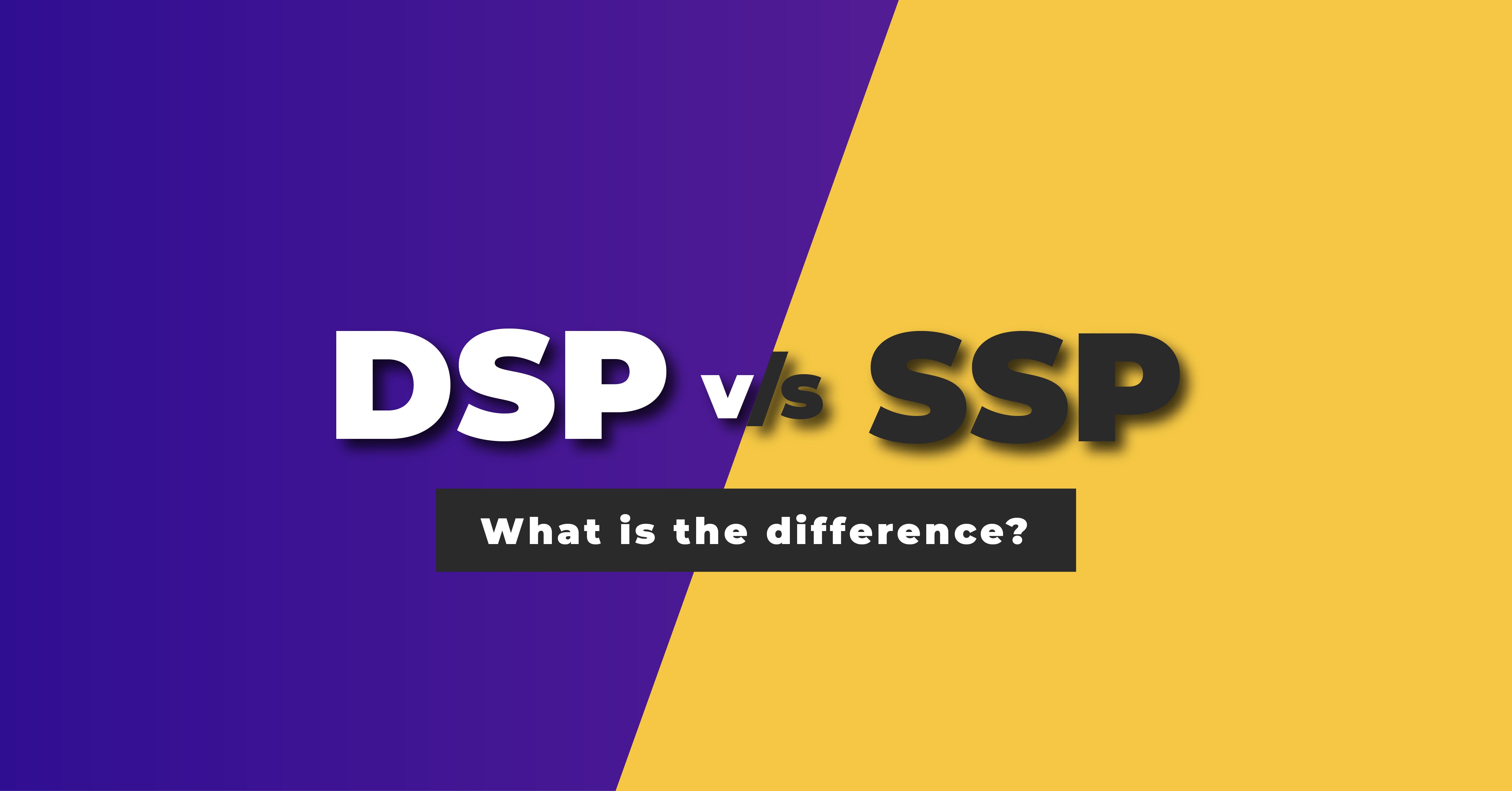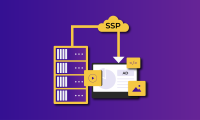What is a DSP? Definition, Types, DSP vs SSP
Prior to the 2000s, ad buying was marked by labor-intensive manual negotiations between advertisers and agencies. This traditional approach proved to be inefficient and time-consuming. However, with the emergence of demand-side platforms (DSPs), the landscape of ad buying underwent a significant transformation.
This programmatic platform played a pivotal role in shaping the ad tech ecosystem. By aggregating ad inventories from publishers and various sources, DSPs have become a powerful catalyst for programmatic advertising.
What is a demand-side platform (DSP)?
A demand-side platform is a technology-based programmatic platform that automates the buying process for ad inventory across multiple ad exchanges, SSPs, and publishers, using real-time bidding (RTB) and targeting capabilities. The analog process involved multiple intermediaries, such as salespeople and ad networks, which added complexity and reduced transparency.
The challenges with this traditional process included limited reach, lack of targeting capabilities, slow execution, and inefficient use of ad inventory. Demand-side platforms were introduced to programmatic advertising as a means to provide a more efficient and scalable solution that could automate the ad buying process, offer better targeting options, and enable real-time optimization.
How does a DSP work?
Here’s a step-by-step overview of how the demand-side platform works:
- Advertisers set up their campaigns, defining objectives, budgets, targeting parameters, and ad creatives within the DSP’s user interface.
- The DSP offers advanced targeting options, allowing advertisers to reach specific audiences based on demographics, interests, behaviors, and locations.
- The DSP aggregates ad inventory from various sources, such as ad exchanges and publishers, offering a selection of available impressions.
- Through real-time bidding (RTB), the DSP participates in auctions, analyzing user data and inventory to determine optimal bids for ad impressions.
- When the DSP wins an auction, it serves the tailored ad creative in real-time on the publisher’s website or app.
- The DSP continuously tracks campaign performance, leveraging optimization algorithms to adjust bidding, targeting, and creative elements for better results.
- Advertisers receive comprehensive reporting and analytics, enabling data-driven decision-making and campaign refinement.
What are the types of DSPs in programmatic advertising?
- Full-service DSP
Full-service demand-side platforms (DSPs) provide advertisers with comprehensive end-to-end solutions for programmatic ad buying. This type of DSP offers a complete suite of services such as campaign management ad inventory optimization, audience targeting, and reporting.
By opting for a full-service DSP, advertisers can benefit from a hassle-free experience. They can rely on the expertise and capabilities of the DSP to handle all the intricacies of programmatic advertising. This allows advertisers to focus on their core business while leveraging the DSP’s resources to maximize their programmatic revenue.
- Self-serve DSP
Self-serve DSPs, as the name suggests, provide advertisers with a self-service platform where they have direct control over managing and optimizing their ad campaigns. Advertisers can set up, monitor, and adjust their campaigns independently without relying on a managed service or external assistance.
Advertisers with a deep understanding of their target audience, specific campaign objectives, in-house expertise, and resources can leverage the flexibility and control offered by self-serve DSPs.
- White label DSP
A white label DSP refers specifically to a platform that can be rebranded and customized for use by other companies or agencies. It allows them to offer programmatic advertising services under their own brand name, utilizing the technology and functionality provided by the white label DSP provider. This type of demand-side platform can offer self-serve capabilities, enabling advertisers to manage their campaigns independently.
- Mobile DSP
A mobile DSP is a demand-side platform specifically designed for mobile ad buying and optimization. It targets and delivers advertisements to mobile devices such as smartphones and tablets. Given the rise in programmatic in-app mobile advertising, this type of DSP has become increasingly important in reaching and engaging with their target audience.
Similar to device-specific demand-side platforms, there are inventory-specific DSPs such as video DSPs that cater to the needs of advertisers focused on video advertising. These DSPs provide features and functionalities specifically tailored for video ad buying, such as pre-roll, mid-roll, or post-roll video ad formats, video ad targeting options, and video-specific metrics and reporting.
- Vertical-specific DSP
Vertical-specific demand-side platforms (DSPs) bring specialized expertise and insights to advertisers operating within specific industries or niches. By focusing on a particular sector, these DSPs understand the unique dynamics, target audience, and industry-specific metrics that drive success.
Their in-depth knowledge and understanding of the specific industry, its trends, consumer behavior, and competitive landscape, allow them to provide tailored strategies and recommendations. They have access to niche data sets, audience segments, and contextual targeting parameters specific to the sector. This enables advertisers to reach their target audience with precision and relevance, maximizing campaign effectiveness.
What are the features of a DSP in advertising?
Here are the best DSP features offered by top players in the ad tech industry:
- Campaign management
Campaign management is one of the core features of DSPs (Demand-Side Platforms). It encompasses various aspects of configuring and optimizing ad campaigns. Advertisers can set up and configure their campaigns, including defining campaign objectives, targeting parameters, ad creatives, and other campaign settings.
They can also set a frequency cap that allows advertisers to control the number of times their ads are shown to individual users within a specified time period. This helps manage ad fatigue and strike a balance between ads and user experience.
- Mobile and video advertising
DSPs enable advertisers to effectively reach their target audiences through mobile devices and deliver video ad content across various platforms. They integrate with inventory-specific programmatic platforms such as video ad networks to gain access to their inventory of video ad placements.
DSPs also facilitate the delivery of in-app advertisements, allowing advertisers to target and engage users while they are using various mobile apps. They also support advertising on mobile websites, enabling advertisers to display ads when users browse websites on their mobile devices. They support varied ad formats such as mobile banners, responsive ads, and mobile-friendly native ads that can be utilized to engage mobile web users.
- Data integration
Data integration is a valuable feature of DSPs in programmatic that benefits advertisers, even if they don’t have their own first-party data. DSPs enable access to third-party data through integrations with data providers and marketplaces. This integration empowers advertisers to tap into a vast array of consumer insights, demographics, and interests.
By leveraging third-party data within a DSP, advertisers can enhance their audience targeting and campaign optimization strategies. They can refine their targeting parameters and deliver more relevant and personalized ads to the desired audience segments. Through data integrations, DSPs offer advertisers a comprehensive ecosystem of data-driven insights and tools, enabling them to make informed decisions, optimize their campaigns, and achieve their objectives.
- Bidding strategies
DSPs offer a range of bidding strategies for advertisers participating in real-time bidding (RTB) auctions. This feature is crucial in optimizing ad campaigns and achieving desired outcomes. However, it’s important to note that different DSPs may provide varying bidding strategies, and advertisers should carefully consider these factors when selecting a demand-side platform for programmatic ad buying.
These strategies may include manual bidding, automated bidding, dynamic bidding, bid shading, and the choice between first-price and second-price auction models. Each strategy has its own advantages for advertisers.
- Reporting and analytics
DSPs typically have their own internal web analytics systems to track and report on campaign performance. These internal analytics provide advertisers with real-time data and insights. Additionally, some DSPs may integrate with external analytics platforms like Google Analytics 4, allowing advertisers to combine the data from both sources for more comprehensive reporting and analysis.
The insights cover a range of metrics relevant to different campaign types and ad formats such as clicks, click-through rate (CTR), conversions, conversion rate, and cost metrics such as eCPM (effective cost per thousand impressions) or cost per click (CPC).
- Brand safety
DSPs prioritize brand safety by employing content verification tools and advanced technology to evaluate the content and context of websites where their ads are placed. They meticulously ensure that the publisher’s content aligns with the brand’s guidelines and standards.
Additionally, DSPs employ advanced fraud detection mechanisms to identify and prevent fraudulent activities, such as bots or click fraud. They often form partnerships with third-party brand safety vendors or verification providers to enhance brand safety measures. These partnerships enable DSPs to access industry-leading technologies and databases that identify unsafe or non-compliant content, providing real-time protection for publishers’ brands.
DSP vs SSP- What is the difference between the two programmatic platforms?
DSPs revolutionized the ad buying process for advertisers, automating inventory purchases across various ad exchanges and publishers through real-time bidding and targeting capabilities. In contrast, SSPs emerged as a response to the growth of DSPs, focusing on serving publishers’ requirements. They provided publishers with a dedicated platform to efficiently manage and optimize their ad inventory, making it accessible for sale to DSPs.
While DSPs primarily catered to advertisers by simplifying the buying process and enhancing targeting capabilities, SSPs acted as a vital tool for publishers to maximize revenue by connecting their inventory to multiple demand sources. These platforms played distinct roles in the programmatic advertising landscape, each serving different stakeholders with specific functionalities.
| DSP (Demand-Side Platform) | SSP (Supply-Side Platform) |
| Connects advertisers with multiple ad exchanges and publishers, allowing them to access available ad inventory and reach their target audience effectively. | Connects publishers with demand sources such as ad networks and ad exchanges, helping them optimize the selling process and monetize their ad inventory efficiently. |
| Offers advertisers a range of tools and features for campaign management, targeting capabilities, budget management, and optimization to achieve their advertising objectives. | Provides publishers with tools to manage and optimize their ad inventory, set pricing rules, and analyze performance metrics to maximize their revenue potential. |
| Integrates with data management platforms (DMPs) to leverage audience data, enabling advertisers to target specific audiences with precision and deliver relevant ads. | Integrates with ad servers to deliver and track ad impressions on publishers’ websites, ensuring accurate measurement and reporting of ad performance. |
| Empowers advertisers to make informed decisions by providing detailed reporting and analytics on campaign performance, allowing them to measure ROI and optimize their strategies accordingly. | Equips publishers with reporting and analytics capabilities to track ad performance, monitor key metrics, and gain insights that help them maximize their revenue and make data-driven decisions. |
| Focuses on the buying side of programmatic advertising, allowing advertisers to efficiently purchase ad inventory and optimize their campaigns for better results. | Focuses on the selling side of programmatic advertising, enabling publishers to effectively monetize their ad space and connect with demand sources for maximum revenue generation. |
Demand-side platforms play a crucial role in achieving precise targeting, resulting in personalized ads and improved consumer ad response. They provide valuable assistance to both advertisers and publishers in attaining their brand goals and revenue objectives.
By leveraging the capabilities of a DSP in programmatic ads, advertisers can effectively target their desired audience segments with tailored messaging and relevant content. This platform serves as a valuable tool in the advertising ecosystem, facilitating the alignment of advertiser goals with consumer preferences and publisher inventory.




Leave a Reply